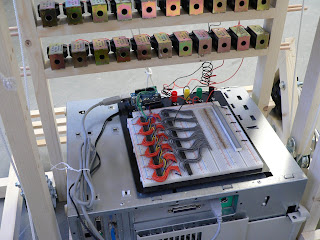I'm working towards the creation of a device to be located in Point Douglas to watch the passing trains and transmit data about their motion to the [Deep|Remote] Listening Device which would translate the data into a strange music. I started prototyping a device using an Arduino board to read a photocell and transmit a signal over CB radio whenever there is an abrupt change in light that would indicate motion past the photocell. Most CB radios have a connector for an external microphone that contains all the basic control lines for the radio. I modified a cable taken from an old AT keyboard that happens to match the 5-pin DIN connector on the CB radio.



To transmit with the CB radio, the radio's TX line must be connected to the ground line, causing any signal applied to audio line to be transmitted. (This is the basic operation when using the CB radio's external microphone; pressing the button on the microphone causes any sound picked up by the microphone to be transmitted over the radio). I attached a 2N3904 transistor to one digital pin on the Arduino board to control the TX line. Tones are sent out from another digital pin on the Arduino.

This picture shows the Arduino connected to the portable CB radio. In the middle is the photocell (shielded by the blue straw) connected through the coil of green and black wire. This is the code I developed for the Arduino to send a sequence of two tones over the CB radio whenever there is a substantial change of light detected by the photocell:
Motion_Bleep.txt
You can hear the tones produced over the CB radio by clicking the following link:
Two_tone.mp3



